Graceful hyacinths delight the eyes on the flower beds and in a bouquet, and with the advent of spring - on the windowsill. Forcing will require in-depth knowledge of planting material, otherwise flowering is difficult to wait. It is important to prepare the planting material well for the open ground, to dig and preserve the bulbs correctly.
Material Content:
Description of species and varieties
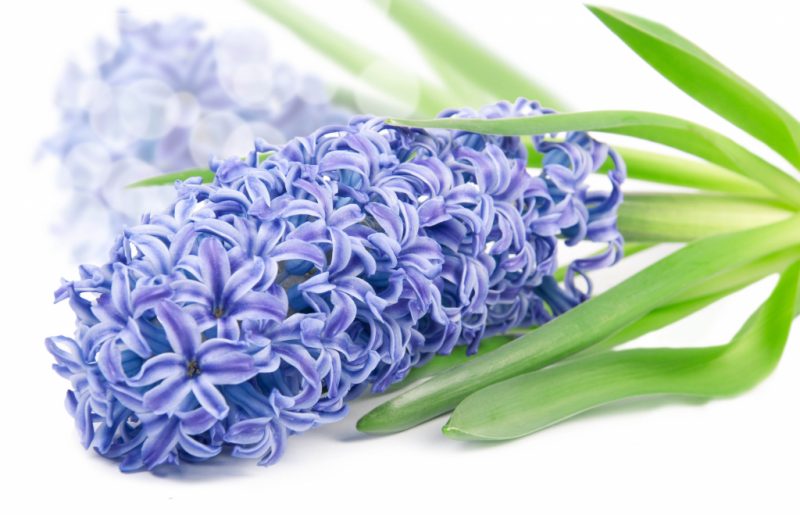
Hyacinth is a beautiful bulbous perennial. A thick or loose apical brush consists of a large number of simple or double flowers. Modern hybrids are distinguished by large inflorescences of various shades.
For outdoor cultivation

- "Anna Lisa." An early variety with purple inflorescences that do not fade for almost three weeks.
- "Carnegie". Snow-white hyacinth with loose cone-shaped inflorescence.
- "Miozotis." An early variety with fragrant light blue inflorescences.
- Grand Blanche. Peduncle up to 20 cm high, corollas white, large.
- "Gertrude". Late hyacinth with flowers of saturated pink color.
- Red Magic. Hyacinth with large bright pink inflorescences.
- "Anna Marie." A variety with pale pink petals.
Indoor varieties
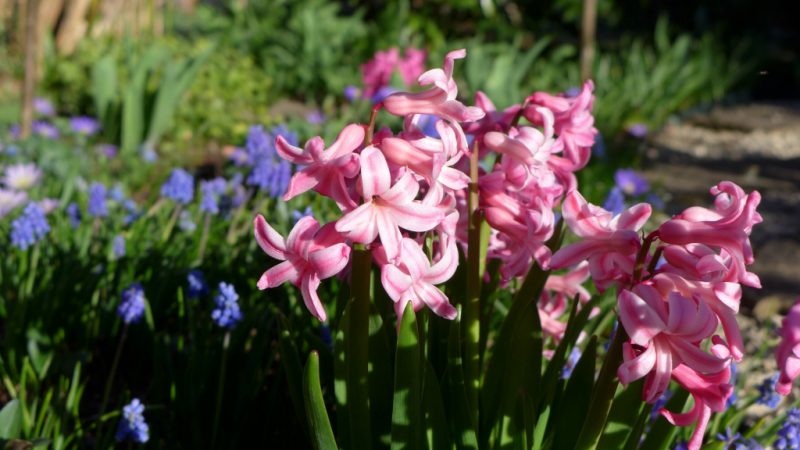
This group usually includes the same varieties that are grown in open ground, and are suitable for distillation indoors. Early dates for flowering specimens are timed for Christmas. Bulbs of the Anna Marie, Marconi, Delft Blue grades are used. Later hyacinths bloom from January to March 8, some until April. The varieties “Anna Lisa” and “Woodstock” are mainly used.
Planting hyacinths in open ground
Experts recommend preparing the place in advance.A few weeks before the scheduled date, deeply dig up the soil. Contribute to sand, some peat and humus. It is advisable to add superphosphates, potassium and magnesium sulfates.
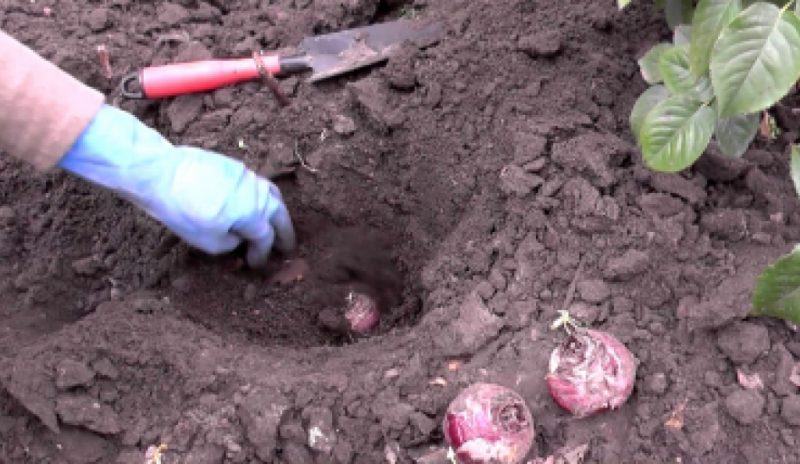
In the central part of the country, hyacinths are planted in gardens from mid to late autumn. It is important that they do not grow early.
Experienced "hyacinth growers" warn novice growers about the rules for choosing corms. The largest of them go for distillation, and smaller specimens are better for growing in gardens. They give well-developed flower stalks, which are also more resistant to difficult weather conditions.
Each plant needs a feeding area of 15x20 cm.
- The bottom is deepened into the soil by about 15 centimeters. Small bulbs and children can be planted denser, closer to the surface.
- At the bottom of the prepared grooves, washed sand is distributed (preferably river), into which the bottom is slightly pressed.
- Create a “shirt” of sand around the bulb, then fill the groove with soil.
- Dry earth watered. Sandy “shirt” serves as a drainage layer and protects against infection.
You can plant flowers on the ridges for quick warming of the bulbs in spring and raising above the level of melt water. Cultural specimens are planted, keeping a distance of 20 cm between them. If necessary, the ridges are covered with a film.
Shelter will also be required in the fall. Mulching substrates, such as peat, humus, wood shavings, are used. You can cover with spruce branches or dry foliage collected in the garden, park. Carefully remove mulch materials in spring when the ground thaws.
How to care for flowers in the garden
The flowers in question are not capricious, but rather demanding. Around the plants should not be weeds, dry leaves, fallen flowers. Loosening is carried out 2 to 3 times during the warm season. Watering is recommended to be carried out during a drought and to combine them with top dressing containing nitrogen.
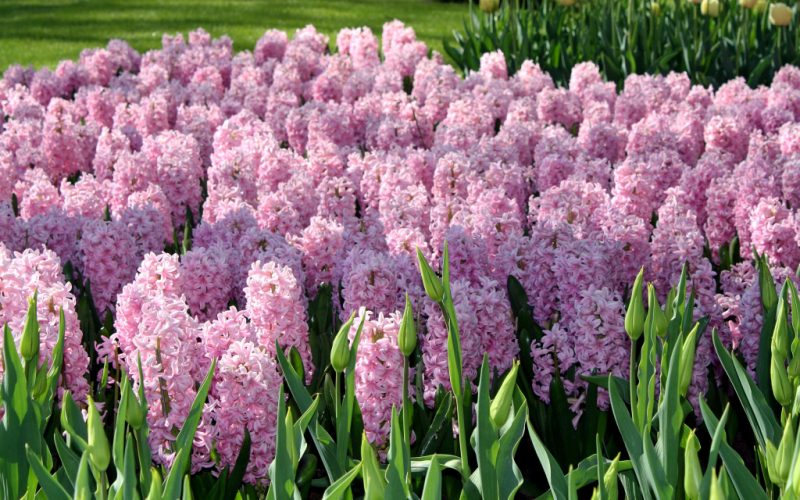
After the hyacinths have faded, the “column” is cut with a sharp knife. You can leave the flower stalk by breaking off only drying corollas. Thanks to this simple procedure, it is possible to obtain larger and ripened bulbs. It is important to timely remove affected and diseased plants, preventing the spread of infection.
When to dig out and how to store hyacinth bulbs
Dig bulbs of Dutch hyacinths after flowering and yellowing of leaves. The best time for this important event is in early July.
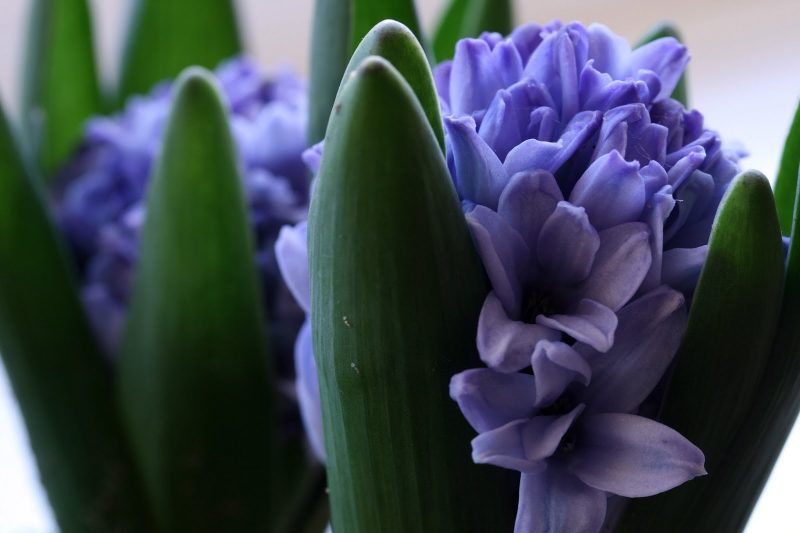
- Children are immediately separated for rearing.
- Healthy bulbs are processed to prevent the development of diseases.
- Damaged, infected material is destroyed.
The process of laying the future inflorescence begins almost immediately after the death of the ground part or even earlier. Experienced growers and breeders recommend rinsing the bulbs with running water after digging. They are dried in the air in the shade of a tree or under a canopy for 5-7 days at 20 ° C.
Clean, well-dried, hyacinth bulbs sorted by size are laid in storage.
- Lay the material in flat boxes in one or two layers.
- If the bulbs are few, then they are stored in paper bags with labels indicating the variety.
- The first two months the bulbs are kept at elevated temperature (25 - 26 ° C).
- The second stage of storage provides cooler conditions (17 ° C).
- The bulbs should not be completely dried or waterlogged.
The total shelf life of the bulbs is 3 months. Immediately before planting hyacinths, a kind of hardening is carried out. For this purpose, the bulbs are stored in a cool room until the end of September - beginning of October. With delay and too low temperatures in the first stage, hyacinths give short, loose inflorescences.
Growing and caring at home
To drive hyacinths on the windowsill, you will need pots or containers filled with a substrate (take equal parts of turf land, peat and coarse sand). At the bottom of each tank, drainage is necessary. To this end, lay gravel, expanded clay or coarse pebbles with a layer of 1.5 cm. Sprinkle with coarse washed sand on top, then add the prepared substrate and watered.
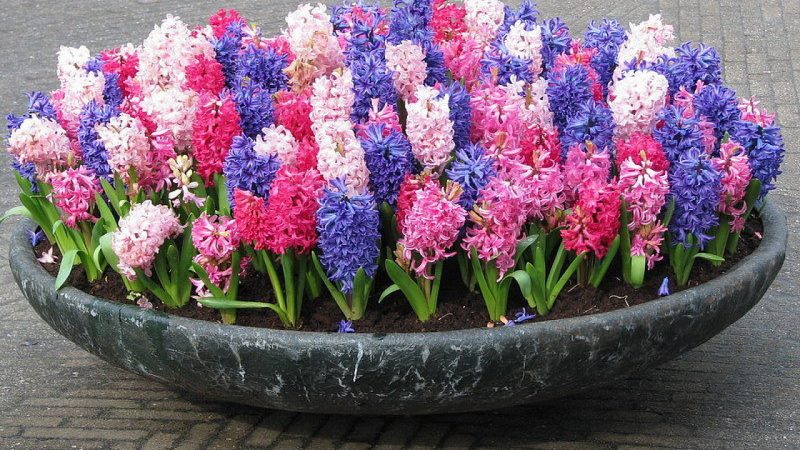
Hyacinth planting begins in November.
- Bulbs of large size are pressed with the bottom into the substrate.
- Sprinkle with soil so that the uppermost part remains open.
- The soil is compacted around the bulbs, watered abundantly, but without stagnating water.The top of the bulb, when properly planted, should protrude 1.5 cm above the substrate, but not higher than the edges of the pot or container.
- Hyacinths are covered with paper cups on top, under which the formation of the root system and kidneys will take place in the dark.
- Bulb containers are sent for 6 to 7 weeks in a cool, unlit room.
For off-season storage and preparation of hyacinths for distillation, you can use the basement. Either add containers with bulbs in the greenhouse, cover with suitable material. Other options are suggested by the experience of gardeners, savvy gardeners and lovers of indoor plants.
The soil in the container should be moist, but not swampy. A temperature of 6 to 9 ° C is most favorable for distillation. If it is warm at home, in the pot the roots grow back more slowly, the development of peduncles is delayed.
After rooting over the soil, conical sprouts of hyacinths appear. When the shoots reach a height of 8 - 10 cm, containers with bulbs are transferred to a warmer place. Gradually accustom the flower to bright light, removing paper cups for several hours. Then the shelter is completely removed and watering begins more abundantly.
Hyacinths flowers bloom 3 weeks after they receive enough light and moisture. The quality of peduncles, the time of blooming in winter or spring depends on the planting material, as well as on the conditions during the dormancy period of the bulbs and during forcing.
Plant propagation methods
Used seed and vegetative propagation. The first method is practiced mainly by breeders. The plants obtained from the seeds do not inherit the varietal traits of the parent form; they bloom after 6 or 7 years.
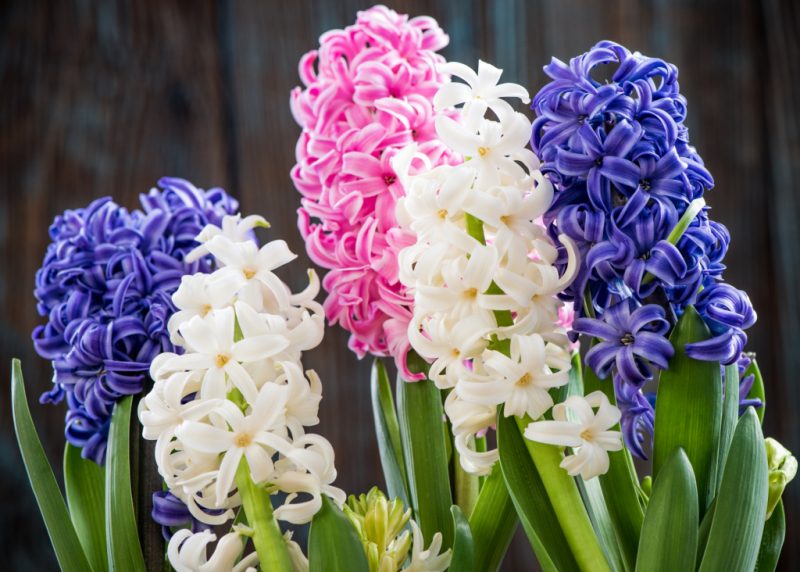
Vegetative propagation is easier to implement. Every year, children (1 - 8 pieces) grow from the mother's bulb, which must be planted and grown. Small bulbs will bloom only after 4 - 5 years. In nurseries, artificial reproduction of hyacinths by cutting the bottom is still practiced. The method is complex, but allows you to get a sufficient amount of planting material.
Protection against diseases and pests
Hyacinths are little affected by various pathogens and harmful insects in the open ground. In a distillation room and in greenhouses, so-called nursing diseases can spread. Hyacinths do not tolerate acidification and waterlogging of the soil, do not bloom well with excess manure or nitrogen fertilizers, thickened plantings.
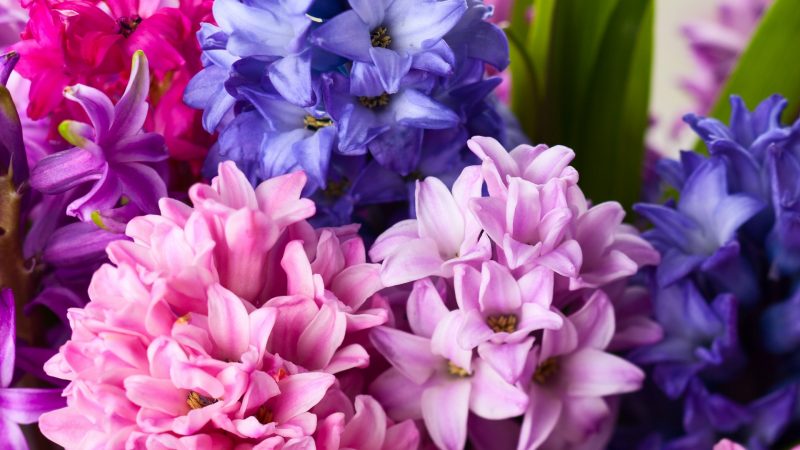
Only high-quality material should be purchased, pickled bulbs after digging and before planting. With all the requirements, hyacinths rarely get sick.












